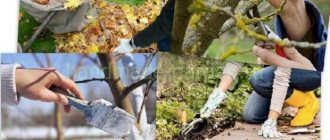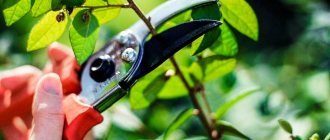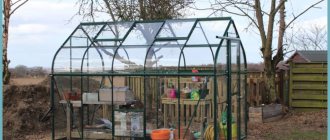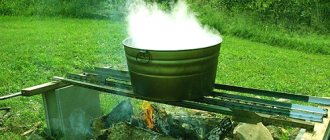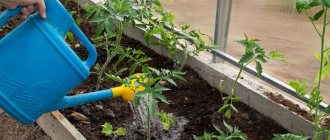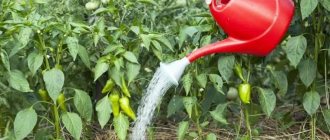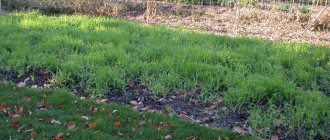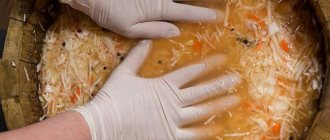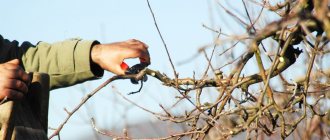With the onset of autumn, it is time to prepare the garden for winter, including treating trees against diseases and pests.
It is extremely important to treat green spaces in the garden. The soil in the tree trunk, bark, and fallen leaves are all wintering zones for pathogenic microflora and parasitic insects.
Destroying them means preventing many diseases next year.
In this article we will tell you how and with what means you should spray the trees in your garden in the fall.
Why treat trees in the fall?
Some summer residents do not spray, considering it useless. However, this is far from true; by carrying out timely preventive spraying in the fall, you can achieve the following goals:
- protect the plant from fungal infections;
- eliminate pests;
- protect the bark from dying. Many pests damage the bark, which leads to the process of wood decomposition beginning;
- increase the immunity of trees.
There are many reasons for spraying; experienced gardeners recommend treating the garden in the fall and spring immediately after the vegetation awakens. Thus, the plant will quickly move away from the dormant period and begin an active growing season.
How to choose the time to treat your garden in the fall against diseases and pests?
It is necessary to treat garden plantings in the fall only after the entire harvest of fruits and berries has been collected. Spraying is carried out from the end of September to November.
For spraying to be effective, experts recommend doing it only after the foliage has completely fallen off the branches.
However, each crop has its own specific timing for leaf fall, so often, to save time, spraying is carried out at the end of October, when the entire garden is already bare.
How to prepare fruit trees for autumn processing
In order not to harm fruit crops before spraying against pests and diseases, the area must be properly prepared. First of all, remove all fallen leaves. Often pests hide in the foliage when the temperature drops.
Next is the next step. Inspect the branches and remove old, cracked bark and lichens that may harbor pests.
Once the tree is prepared, it can be sprayed with fungicides, insecticides or tank mixtures.
NOTE! The soil around the crop should also be treated. This must be done before digging the soil in the fall.
Treatment of fruit trees and shrubs with folk remedies
To spray trees and shrubs against pests and diseases, products prepared according to folk recipes can be used. Each method has repeatedly proven its effectiveness and is ideal for the garden.
Garlic infusion
Garlic infusion is effective against a large number of pests. To process garden crops, you need to chop 100 grams of garlic and add 1 liter of water. Then leave for 24 hours and strain. Dilute the resulting liquid in 5 liters of water and treat the plantings.
The consumption rate is from 5 to 10 liters, depending on the size of the plant.
Potassium permangantsovka
An effective remedy that can protect the plant from fungal diseases. To prepare the solution, you will need to dissolve 3 grams of potassium permanganate in 1 liter of water and sprinkle shrubs and flowers with this solution. Large trees are best treated with stronger fungicides.
Abundant watering
It is important that the fruit trees go to winter without drying out. If the autumn was not rainy enough, thoroughly water the soil in the tree trunk circles. During autumn watering, use approximately 50 liters of water per adult plant. Water the trees in stages: approximately 12 to 15 liters per hour. The soil should become moist to a depth of approximately 1 m. Please note that the water temperature should be 5°C higher than the ambient air temperature outside.
After watering, mulch the tree trunk circles with peat, spruce spruce branches, humus or compost. This will help retain moisture in the soil.
Treating trees in the fall with ready-made preparations: how to dilute them correctly
Ready-made preparations are often used to spray trees. The peculiarity of the drugs is that they are universal and can protect against many diseases and pests.
Copper sulfate
One of the most effective spraying agents against diseases and pests. It needs to be treated after the end of the growing season, that is, just before the onset of frost.
It is recommended to spray trees in the fall with a 3% solution of copper sulfate.
Bordeaux liquid
An effective remedy against diseases. Used both in autumn and spring. For the garden it is necessary to use Bordeaux mixture 1%. After the initial spraying, experts recommend repeating the spraying after 10 days.
inkstone
Iron sulfate is widely used in gardening. The remedy is very effective against fungal diseases. Suitable for spraying fruit trees, shrubs, including grapes. To spray, you need to prepare a 5% solution and treat the garden with it.
Caring for strawberries and strawberries
After removing the trimmed leaves and old mulch, where pests hide for the winter, you can begin processing the strawberry bushes. This crop is susceptible to many fungal infectious diseases, and this crop has plenty of pests. Autumn is the time when chemicals will not poison strawberries and wild strawberries, so processing can be carried out without fear.
Spider mites planning to spend the winter on bushes will die when treated with acaricides. These drugs are designed specifically to destroy populations of sucking-gnawing microscopic parasites.
- The following preparations are very helpful in clearing strawberry plantations of mites: Apollo; Flumite; Omite; Sunmite; Neoron, Nissan.
- Larger enemies of strawberry beds die from the use of insecticides, the most popular drugs among them: Karbofos, Fufanon, Actellik, Fosbecid, Rovikurt, Inta-vir, Tsipershans.
Preventive treatment against diseases is carried out using copper-containing preparations.
How to use fungicides for autumn treatment of trees
Ready-made fungicides are good because they are highly effective and adapted to combat the most common infections.
Among the most effective it should be noted.
Topaz
The product is used against fungal diseases. Suitable for both treating infestations in the garden and as a preventive measure. To make the result more effective, experienced summer residents recommend repeating after the first spraying.
Fundazol
An effective remedy that eliminates most fungal infections from the first procedure. Penetrates deep into the cortex and destroys pathogenic microflora.
Aktara
One of the best insecticides. They need to be sprayed before the trees go dormant. Suitable for spraying fallen leaves and tree trunks.
Aktellik
Protects fruit trees from a wide variety of pests. Process in warm, windless weather. Prepare the working solution in strict accordance with the instructions.
Maksim
An effective product that can be used both for the garden and vegetable garden. It not only destroys existing diseases, but also protects the plant from new diseases. You can get the desired result in the fall by spraying even once.
What to do in the garden before processing
Pests like to gather in fallen leaves and cut branches, and if there are still heaps of unharvested garden tops and weeds in the garden, you can expect an invasion of diseases and harmful insects next year.
Before starting to treat trees against pests, it is necessary to clean the garden area and burn all plant debris infected with pathogenic infections. Tops of diseased plants and pruned branches of infected trees should not be placed in the compost heap.
It is worth paying special attention to the pre-winter treatment of cultivated plants in the garden, because the prospects for the future harvest directly depend on this. Preparing the garden for winter is aimed at solving several problems:
- Freeing plants from insect pests.
- Elimination of foci of pathogenic infections on garden plants.
- Reducing the risk of damage to garden plants from rodents.
- Warming the garden in winter.
Biological preparations for treating trees in autumn
Biological drugs are highly effective. The drug is based on beneficial bacteria, which increase the immunity of trees and their resistance to the adverse effects of pathogenic microflora and insect pests.
IMPORTANT! Biological products can only be sprayed at temperatures not lower than +18, otherwise they will not work properly. Processing at +5 +7 degrees is practically useless.
Bitoxibacillin
The product is used to spray the garden against pests. After spraying, the bacteria penetrate deeply into the bark and lead to the death of the larvae and destroy the eggs. The drug can be used to spray the tree or the surrounding soil.
Fitosporin
The product is often used to combat fungal diseases. Effective against diseases such as scab and powdery mildew.
You can prepare a working solution by dissolving the drug in a small amount of water. Then we insist for 24 hours. Before use, dilute 2 tablespoons in 10 liters of water and treat the culture.
REFERENCE. Fitosporin shows results when used at a temperature not lower than +18.
Aktofit
Eliminates pests such as scale insects and spider mites. It affects not only adults, but also larvae. Suitable for both autumn and spring processing.
How to spray plants
At this time, gardening shops sell a wide range of specialized formulations (often combined with fungicides and insecticides) for autumn spraying of garden plots. But we will discuss the most popular means.
- Until mid-October, spraying with urea is carried out. In autumn, this is a good medicine to combat fungal diseases, as well as scabs and spots. In addition, urea perfectly burns insect eggs and harms pupae. But there is no need to use urea at the end of the autumn period (closer to winter), since this composition feeds the plant with nitrogen. Urea is very often used as a nitrogen supplement. If you spray the garden with it for the winter, vegetation processes are activated in the plantings. The garden will not have time to prepare for sleep before the cold weather begins and, most likely, will die. For this reason, treating trees with urea in the fall is allowed, but only until the end of October. A month before the onset of frost, there is no need to sprinkle the garden with urea.
- To combat scab, powdery mildew and putrefactive diseases, other fungicides should be used. For example, treating trees with copper sulfate in the fall shows an excellent effect. This product can be used at any time of the year.
- If you add slaked lime to copper sulfate in a 1:1 ratio, you get the so-called Bordeaux mixture - a good composition for parallel combat against diseases and insects. Treating trees with Bordeaux mixture is the most famous type of spraying today. The product has a soft bluish tone, so if your plantings are wrapped in a film of heavenly color, there is no need to worry. Over time, the color will be removed, but there will be no hostile insects or harmful microbes in the garden.
- Sometimes trees are treated with iron sulfate in areas, mainly in apple orchards. This fungicide works similarly to copper sulfate, only in addition it feeds the vegetation with iron. This is an extremely important trace element for the Apple tribe. It takes an active part in many oxidative processes in apple trees, plums, cherries, and peaches.
Insecticides can be added to copper or iron sulfate. This will give more successful control of insects.
After carrying out all the autumn activities (pruning, treating trees with fungicides, whitewashing, placing insulation and protective equipment), do not forget to clean the planting area. You do not process waste in the form of fallen leaves and trimmed branches, but insect pests can easily live in them and pathogens can breed. For this reason, all garbage must be collected and burned.
How to carry out autumn whitewashing of trees
Whitewashing is an effective and time-tested means of pest control. It is necessary to whiten the trunks before the onset of frost. The whitewashing process is carried out according to the following algorithm:
- slaked lime or special garden whitewash is used;
- the consistency of the solution should resemble thick sour cream in order to adhere well to the bark;
- trees and young seedlings must be whitened to a height of at least 1 meter;
- It is best to apply whitewash in several layers to make the procedure more effective.
Whitewashing also has a detrimental effect on most fungal diseases and eliminates larvae that may be hiding in the bark.
NOTE! Lime is effective against rodents. By whitening the trunks of young bushes and seedlings, you can avoid the attack of hares.
In what cases is it not advisable to treat fruit trees in the fall against diseases and pests?
In the fall, it is not recommended to spray the garden against diseases and pests if any tree or shrub bears fruit before the first frost.
Also you won't be able to spray at the end of November. Usually at this time there are night frosts, and spraying can be harmful.
When to treat trees in the fall of 2022 according to the lunar calendar from diseases and pests
For summer residents who cannot determine the appropriate period for spraying, you need to use the recommendations of the lunar calendar.
Deadlines
Carrying out autumn garden treatment does not have specific dates, but depends on natural factors. The events correspond to the following periods:
- The leaves begin to turn yellow, which most often happens at the end of September. At this time, you need to dig up the soil and apply fertilizer.
- All the leaves turned yellow and began to fall off. During a dry autumn, you need to moisten the soil abundantly. The trunks are whitened, the crowns are pruned, and the young plantings are hilled. To combat mice, it is better to install traps and baits with poison.
- The leaves have fallen en masse. All leaves should be collected and composted or burned.
- The ground freezes, which happens already in November. Additional mulching and chemical treatment are carried out. Trunks and bushes are wrapped in breathable material or spruce branches to prevent rodents.
Peculiarities of processing fruit trees in different regions
When cultivating a garden, it is important to take into account the characteristics of the region in which the summer resident lives.
For example, in the Krasnodar region you can spray trees with fungicides and insecticides as early as November, but in the Omsk region spraying will have to be completed in the first ten days of October.
Southern regions
For warm regions, spraying can be carried out until the end of November. Plants tolerate chemicals well. The procedure should be carried out only after the foliage has completely fallen from the branches.
Northern regions
For regions such as the Urals and Siberia, trees in the garden should be sprayed before the end of September or, at least, before the first ten days of October.
If the procedure was not completed in a timely manner before the first frost, it is postponed until early spring.
Moscow region
It is necessary to process after the crop has been harvested and the leaves have completely fallen. The most suitable period is considered to be mid-October.
Cleaning leaves from the garden
Use a rake to carefully collect the leaves. If your shrubs and trees have not been affected by diseases and pests, send the leaves to a compost heap or to warm beds, and use them as mulch for wintering flowers. But keep in mind: leaves infected with scab, powdery mildew and other diseases are not suitable for this. Take them off your property and burn them.
Don't forget to remove leaves from the roofs of all your buildings located on the site!
Gardening Tips and Tricks
Experienced summer residents advise following the following recommendations when spraying the garden against pests and diseases in the fall:
- use of wood ash. Wood ash is versatile and will protect your garden from pests and diseases. To spray, pour 1 kg of ash into 3 liters of water and mix thoroughly. Using a broom, spray bushes and trees;
- During whitewashing in the fall, add a teaspoon of copper sulfate to the lime. This mixture will protect the tree from pests;
- After digging up the soil, treat it additionally. Some pest larvae may be hiding in the ground. During digging, the larvae are removed to the surface, and spraying allows them to be eliminated in a timely manner.
Important nuances and rules of spraying
When processing fruit trees, special spray equipment is used. It can be manual or mechanical. The device is not important. You just have to pump up the solution regularly when working manually.
Working with any of the devices involves the distribution of chemical vapors in the air and their contact with the gardener’s skin and mucous membranes. Therefore, it is important to carry out work in special protective clothing and a respirator.
Otherwise, they act according to the following recommendations:
- Select medications depending on the diseases or pests on the tree.
- Carry out processing only in dry, not rainy weather. Otherwise there will be no point in spraying. The rain will wash everything away.
- Be sure to wait for calm weather. Otherwise, the wind will blow the chemicals past the trees.
After processing, tree trunks need to be thoroughly whitened. The lime layer is at least 3 mm. If there are wounds on the trunk, then manure and chopped straw are added to the lime.
Interesting: How to prepare fruit trees for winter
Common mistakes
Summer residents often make mistakes that can have a detrimental effect not only on the yield, but also on the appearance of garden trees. Among the most common mistakes are:
- processing at inappropriate times. Spraying in the fall should be done after the leaves have fallen. If the procedure is carried out earlier or later, the effect will be minimal;
- simultaneous use of several drugs. Such actions often lead to burns on the bark and the tree becomes weak. The intervals between spraying should be at least 15 days;
- treat the garden before pruning. To get the maximum effect, you need to spray the garden against pests and diseases in the fall only after pruning.
In order not to make mistakes, it is necessary to strictly follow all agrotechnical recommendations for caring for the garden.
Why did I refuse any preventative garden spraying?
Many gardeners act according to this scheme (again, just to be sure): they carry out eradicating spraying in the autumn, and in early spring they practically repeat it, finishing off everything that survives. Theoretically, everything is correct, and diseases and pests simply have no chance. None.
But in practice, everything is not quite like that, but rather, it’s not like that at all.
And the point here, most likely, is that your site is not limited by the fence that you and your neighbors built. No, your plot is part of a large and complex ecosystem, which includes neighboring plots, a nearby forest, and the fields of some agricultural company.
Spores of fungal diseases, as well as eggs and larvae of insect pests, are literally everywhere. No matter how much you spray your garden, you will not be able to completely get rid of them. Well, you must admit, it’s possible to go over all the cultivated plants with the solution, but over all the weeds, over every square meter of the earth’s surface, over all the garden furniture, buildings, equipment - well, it’s very difficult! And if you consider that many “bad” microorganisms rest in the ground at depth, then it is completely unrealistic.
But even if we purely theoretically assume that you succeeded and were able to completely “sterilize your area” through repeated chemical treatments, what good is this if the very first breeze brings you new problems from a neighboring area?
And the price of such treatments is too high:
- spent money,
- spent time,
- death of many beneficial organisms,
- saturation of the soil, and therefore the fruits, with chemicals that are not beneficial to our body...
And, the main thing is to realize the complete meaninglessness of what you are doing. Sisyphean work, in a word.
I have already given up all eradication, early spring and other planned treatments. From those treatments that, purely theoretically, should save me from big problems. They do not save, as many years of experience show.
No, I’m not advocating (YET!) to throw away your sprayer and completely get rid of spraying your garden. Sometimes real epidemics and invasions happen. That’s when I use certain medications. As they say, I solve problems as they arise.
Let's say I have an old pear tree that had aphids on it this season. I did not notice any significant reduction in yield. These insects did not cause any visible damage to the tree (except for aesthetic damage - twisted leaves). Or here - plum. At the end of summer, year after year, it is “attacked” by rust. But I am always with the plum harvest.
You stand in front of such a tree and think: chemistry and beautiful leaves or healthy fruits (without chemistry), but with spotted foliage? I choose the second one.
It’s a completely different matter if a disease or pests threaten the very life of the plant, especially young seedlings. This is where you should keep a sprayer and some emergency medicine in stock.
Another important point. All the diseases and pests in the garden are part of the same ecosystem, and someone feeds on them. If we kill all the pests, there will be nothing for predatory insects and birds to eat, and they will voluntarily leave our garden. And this will open the door to new pests and diseases. Do you feel how everything is interconnected? In a normally functioning garden there should be both “harmful” and “useful”, but you need to learn to maintain a balance between them.
And, of course, it’s worth paying attention to the selection of plants and species diversity. There are plants that are not susceptible to most diseases and are not to the taste of most insect pests. This is what you want to fill your garden with.
If you allow me, I’ll give you a metaphor. You can drink analgin as much as you like for a toothache, ruining your stomach and heart, but the problem will not be solved, but will only get worse if you do not go to the dentist. You can regularly place a basin under a dripping tap, or you can replace it. Spraying, I think, does not solve the problem, but only adds more work to us.
By the way, the well-known recommendation to change drugs, supposedly so as not to cause addiction in the pathogen, in fact, as experts note, leads to multiresistance. Simply put, the disease or pest becomes less susceptible to your treatments.
Of course, all these thoughts of mine do not apply to those who grow large crops for sale. So my neighbor goes with a sprayer once a week. But he also carried out the autumn eradication, well, and the spring. Everything is as it should be. Yes, apparently, nothing was eradicated. But apples are big. Fact!
